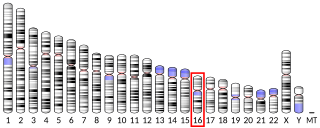
The nuclear receptor 4A1 also known as Nur77, TR3, and NGFI-B is a protein that in humans is encoded by the NR4A1 gene.
The Retinoic Acid-Inducible orphan G-protein-coupled receptors (RAIG) are a group of four closely related G protein-coupled receptors whose expression is induced by retinoic acid.

Rev-Erb alpha (Rev-Erbɑ), also known as nuclear receptor subfamily 1 group D member 1 (NR1D1), is one of two Rev-Erb proteins in the nuclear receptor (NR) family of intracellular transcription factors. In humans, REV-ERBɑ is encoded by the NR1D1 gene, which is highly conserved across animal species.

Zinc finger and BTB domain-containing protein 16 is a protein that in humans is encoded by the ZBTB16 gene.

BAG family molecular chaperone regulator 1 is a protein that in humans is encoded by the BAG1 gene.

Retinoid X receptor gamma (RXR-gamma), also known as NR2B3 is a nuclear receptor that in humans is encoded by the RXRG gene.

COUP-TFII, also known as NR2F2 is a protein that in humans is encoded by the NR2F2 gene. The COUP acronym stands for chicken ovalbumin upstream promoter.

G-protein coupled receptor 31 also known as 12-(S)-HETE receptor is a protein that in humans is encoded by the GPR31 gene. The human gene is located on chromosome 6q27 and encodes a G-protein coupled receptor protein composed of 319 amino acids.

Lysophosphatidic acid receptor 2 also known as LPA2 is a protein that in humans is encoded by the LPAR2 gene. LPA2 is a G protein-coupled receptor that binds the lipid signaling molecule lysophosphatidic acid (LPA).

G-protein coupled receptor 3 is a protein that in humans is encoded by the GPR3 gene. The protein encoded by this gene is a member of the G protein-coupled receptor family of transmembrane receptors and is involved in signal transduction.

G-protein coupled receptor family C group 5 member B is a protein that in humans is encoded by the GPRC5B gene.

G-protein coupled receptor family C group 5 member C is a protein that in humans is encoded by the GPRC5C gene.

G-protein coupled receptor family C group 5 member D is a protein that in humans is encoded by the GPRC5D gene.

Protein kinase C eta type is an enzyme that in humans is encoded by the PRKCH gene.

60S ribosomal protein L7a is a protein that in humans is encoded by the RPL7A gene.

Serine/threonine-protein kinase D2 or PKD2 is an enzyme that in humans is encoded by the PRKD2 gene.

Folate receptor beta is a protein that in humans is encoded by the FOLR2 gene.

Cornifin-B is a protein that in humans is encoded by the SPRR1B gene.

Golgin-45 is a protein that in humans is encoded by the BLZF1 gene.

Butyrate response factor 1 is a protein that in humans is encoded by the ZFP36L1 gene.




















